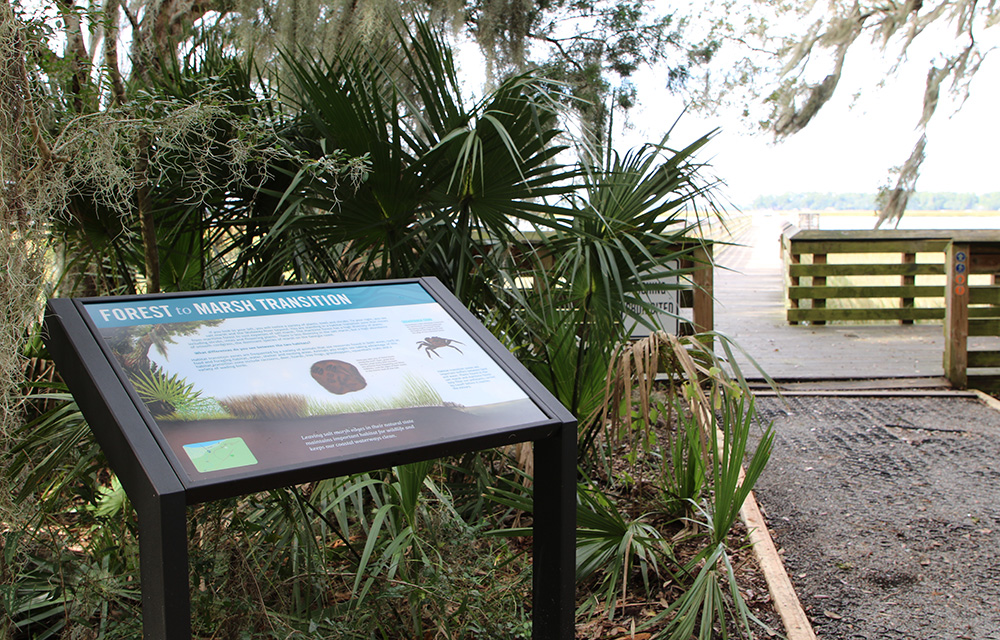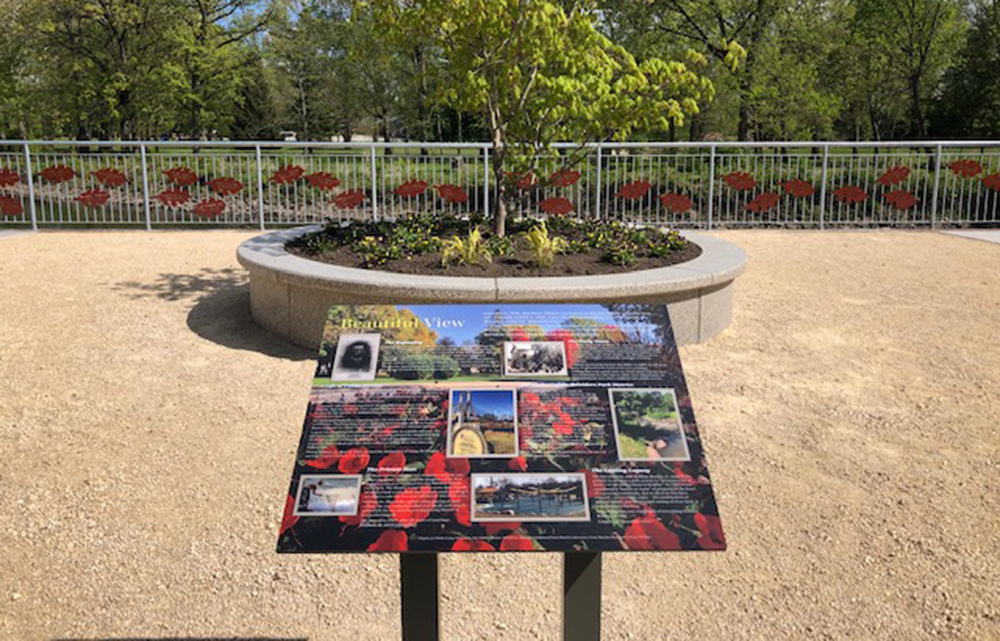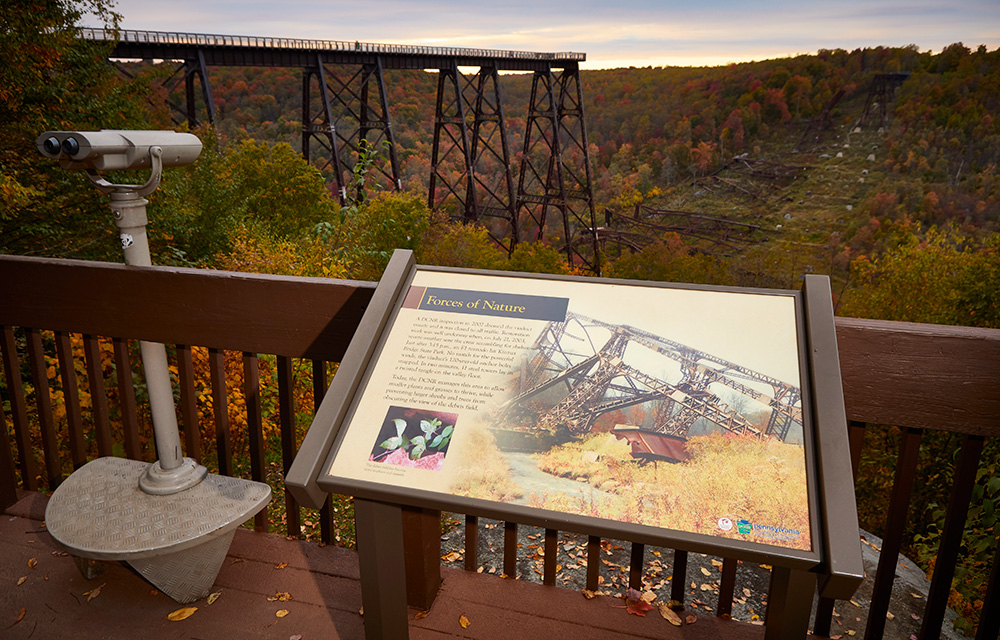May 1, 2025

Interpretive signage is crucial for parks, trails, and conservation areas, as it serves multiple important functions that benefit both visitors and the environment. Here's an in-depth look at its significance:
Enhancing User Experience
Engagement
- Signage enriches the visit by providing valuable information about nature, wildlife, and geology, making the experience more enjoyable and memorable.
- It helps guide visitors, ensuring they stay on trails and navigate the park safely and confidently.
- Visitors learn about the local ecosystem, fostering a deeper appreciation for the environment.
- Signage shares the area’s cultural and historical significance, creating a more meaningful visit.
- Educating visitors on sustainable practices encourages responsible behavior, helping preserve the area.
- Signage directs visitors along established paths, protecting sensitive ecosystems from damage.
- Highlighting conservation issues and endangered species helps promote responsible behavior and protect biodiversity.
Establishing Pannier as a Trusted Partner
Expertise
- High-quality signage demonstrates Pannier’s leadership in environmental education and park infrastructure, earning credibility.
- It fosters trust with conservation groups, park managers, and the public, aligning Pannier with sustainability goals.
- Interpretive signage enhances the visitor experience, educates the public, and supports environmental preservation. For Pannier, it builds credibility and long-term partnerships, reinforcing its role in conservation efforts.
What Are Interpretive Nature Signs?
Interpretive Nature Signs are informational displays placed in natural settings such as parks, trails, or conservation areas. They provide visitors with educational content about the environment, wildlife, history, or cultural significance of the area. The goal is to enhance the visitor experience by deepening their understanding and appreciation of the natural world.Commonly Used Locations
Hiking Trails- Providing information about the ecosystem, local wildlife, or trail history.
- Educating visitors on endangered species, conservation efforts, and wildlife behavior.
- Displaying information on plant species and ecological relationships.
- Informing visitors about marine life, tides, and environmental protection.
Types of Content on Interpretive Signs
Maps- Show trails, points of interest, or the layout of the park/conservation area, helping visitors navigate and plan their visit.
- Artistic representations of animals, plants, or geological features to provide a visual understanding of the area’s natural wonders.
- Real images that showcase the wildlife, landscape, or historical aspects of the area.
- Provides detailed explanations of natural phenomena, species, historical events, or cultural significance of the site.
- Scannable codes linking to additional online resources, videos, or apps for an enhanced educational experience.
- Such as questions, fun facts, or small tasks that engage visitors in learning (e.g., "Can you spot this animal on the trail?").
Purpose
Interpretive nature signs aim to inform visitors in a way that encourages understanding, respect, and care for the environment, while also enriching their outdoor experience with knowledge and context.Benefits of High-Quality Interpretive Nature Signs
High-quality interpretive nature signs offer numerous benefits, making them an essential component of outdoor spaces. Here's why longevity, custom design, accessibility, and educational value are crucial:
Durability
- Made from weather-resistant materials, these signs withstand harsh conditions, reducing the need for frequent replacements and ensuring long-term effectiveness.
Cost Efficiency
- Durable signs save money over time by minimizing maintenance and replacements.
- Long-lasting signs reduce waste and support conservation goals.
- Custom signs can feature specific local history, wildlife, and ecological details, creating a unique experience for visitors.
- Customization allows integration of logos and themes, enhancing park identity.
- Thoughtful design ensures the signs blend with the natural environment, enhancing the park's overall appearance.
- Accessible features, such as large fonts, braille, and high-contrast colors, ensure everyone can read and understand the signs.
- Offering content in different languages makes information available to a broader audience.
- Well-placed, clear signs enhance readability for all visitors.
- Interpretive signs provide educational content about local ecosystems, history, and conservation, enriching visitors' experiences.
- Signs guide visitors on responsible behavior, fostering a sense of environmental care.
- Visuals, maps, and interactive elements make learning enjoyable and memorable.
High-quality interpretive nature signs are durable, custom-designed, accessible, and educational, creating a lasting impact while enhancing visitor experience and supporting conservation efforts.

Materials and Manufacturing Process
Fiberglass EmbedmentPannier Fiberglass Embedded Panels are the standard on which Pannier’s reputation for reliability has been built. Every one-piece Fiberglass Embedded panel delivers superior digital color accuracy, vibrancy, resolution and UV resistance that stand the test of time.
Our proprietary production process ensures that all signs and panels are designed to resist the extremes of weather, are recoverable from the effects of graffiti, and are virtually maintenance-free – making them ideal for almost any outdoor or indoor installation. They are also constructed in a full range of thicknesses and custom shapes, as well as in framed or frameless applications.
Gel Coat Laminate
Pannier Gel Coat Laminate Panels combine the quality and durability of fiberglass with a highly scratch resistant matte finish – making it ideal for applications where a textured look is preferred, yet durability and superior graphics quality are a must.
Each GCL panel delivers the digital color accuracy, resolution and UV resistance that customers have come to expect from Pannier – while providing scratch resistance that is superior to comparable materials. Pannier’s proprietary manufacturing process for GCL creates a chemical bond that enhances the panel’s physical properties – including flexural and tensile strength. The result is a one-piece product that never peels or delaminates, resists the extremes of weather and the effects of graffiti, and is virtually maintenance free. Like all Pannier products, GCL panels are constructed in a full range of custom shapes, as well as in framed or frameless applications.
Regardless of which material you choose, your interpretive nature signs will withstand harsh environments and stand the test of time.
Customization Options
Pannier offers a variety of customization options to help your interpretive signs stand out and convey your message.
Design
- Visually compelling design layouts that reinforce your brand and deliver your message effectively.
- Precise color matching for accurate and vibrant results.
- High-quality paper proofs to approve before printing.
Pannier offers a variety of colors and finishes to ensure the perfect fit for any application. All Pannier frames are available with a high-quality powder coating in these standard colors. Custom colors are available upon request.
Accessories
Pannier offers a variety of accessories that can be adhered to your exhibit base such as brochure holders that display literature to decorative metal that gives your exhibit a touch of customization. Visit our Accessories page to learn more.
Tips for Planning an Interpretive Nature Sign Project
Planning an interpretive nature sign project involves several key steps to ensure the sign effectively communicates with visitors and enhances their understanding of the natural environment. Here are some useful tips for planning such a project:
Identify the Purpose and Audience
Purpose
- Define what you want to communicate. Are you educating visitors about local flora and fauna, ecosystems, or specific conservation efforts?
- Consider the visitors’ age, interests, and experience level. Interpretive signs should be accessible to everyone, including children, tourists, and experts.
- Select a spot where visitors naturally stop or are likely to engage with the sign.
- Ensure it's visible, well-lit, and placed in a spot relevant to the subject matter (e.g., near a particular tree, trail, or water feature).
- Ensure it's accessible and not obstructed by vegetation or other physical barriers.
- Use concise, clear language: Avoid jargon or overly complex terms. Visitors typically don’t have time to read long paragraphs.
- Break down the information into bite-sized pieces: Use headings, bullet points, and short sentences.
- Include visual elements like photographs, illustrations, or diagrams. People often absorb information more effectively with visuals.
- Tell a story: Use storytelling techniques to make the content engaging. For example, rather than just listing facts about a tree, describe its role in the ecosystem or its history.
- Provide information that relates specifically to the local environment. Include details on the local history, ecology, and any unique features of the area.
- If appropriate, include facts about the area’s cultural significance, such as any Indigenous knowledge or stories tied to the landscape.
- Ensure that text is legible from a distance. Choose an easy-to-read font and maintain good contrast between text and background.
- Use a clear layout: Organize information logically (e.g., top to bottom or left to right).
- Use icons and symbols to convey ideas quickly (e.g., a water droplet to indicate information about water sources).
- Keep in mind materials: Signs should be durable and weather-resistant, especially if they're outdoors. Common materials for interpretive signs include aluminum, weather-resistant wood, and high-density plastic.
- Identify the key points you want visitors to remember. Limit the number of facts to 3–5 main ideas to avoid overwhelming your audience.
- Think of each sign as a learning opportunity—focus on giving visitors something they can easily grasp, even if they only glance at the sign.
- If appropriate, consider adding interactive components, such as QR codes that lead to additional resources or audio tours, or tactile elements for visually impaired visitors.
- Create prompts for visitors to engage with nature, like “Can you spot the animal in this tree?” to make the experience more participatory.
- Think about the materials you use and the environmental impact of those materials.
- Ensure the signs blend well with the surrounding landscape, without overpowering or damaging it.
- If the signs are near sensitive areas, consider installing them in a way that minimizes disturbance to wildlife and plant life.
- Pilot test the sign before final installation by showing it to a small group of people from different backgrounds. Gather feedback on whether the content is clear, engaging, and appropriate.
- Revise based on their feedback to improve the message, design, and readability.
- Plan for ongoing maintenance: Over time, signs may need cleaning, updating, or replacing due to weather damage or the need for updated information.
- Ensure that any technological components, such as QR codes or digital elements, remain functional.
- By considering these factors, you can create a nature sign that is not only informative but also an inviting and engaging way to educate and inspire visitors.
Pannier’s proprietary manufacturing process ensures your signs will last for many years to come. We offer a 10 year warranty on our panels, giving you the peace of mind you need to be confident with your purchase. You are free to put any type of graphic within your panel, ensuring that your interpretive signs are ADA compliant and showcase the branding you desire. Our Account Managers are here to walk you through every step of the process, regardless of your budget or how big or small your project is.


Why Choose Pannier for Your Interpretive Nature Sign Project
You should choose Pannier for your interpretive sign project based on our quality products that we produce and our expert advice that we will provide you along the way. Whether it’s your first signage project, or tenth, we will be there with you every step of the way.For more information on Pannier Graphics’ safety signs, please browse our website or fill out a contact form. We look forward to an opportunity to help you with your next signage project!